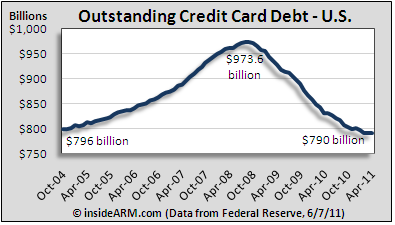Total credit card debt outstanding in the U.S. fell again in April after a very small revised gain in March, according to the Federal Reserve.
 The Fed Tuesday released its monthly consumer credit report which includes revolving (credit card) and non-revolving debt. In April, credit card debt fell by a 1.4 percent annualized rate to $790.1 billion. Credit card debt peaked at $973.6 billion in August 2008. Since then, total credit card debt outstanding has been steadily contracting due mainly to banks charging off the oldest accounts.
The Fed Tuesday released its monthly consumer credit report which includes revolving (credit card) and non-revolving debt. In April, credit card debt fell by a 1.4 percent annualized rate to $790.1 billion. Credit card debt peaked at $973.6 billion in August 2008. Since then, total credit card debt outstanding has been steadily contracting due mainly to banks charging off the oldest accounts.
In the past few months there have been some monthly gains. Last month, the Fed said that credit card debt expanded at a relatively robust 2.9 percent annual rate. But in the release yesterday, the Fed downwardly revised that gain to a paltry 0.1 percent.
Non-revolving debt – comprised of closed end credit like student and auto loans – rose at an annualized rate of 5.3 percent in April. The non-revolving debt reported by the Fed in its monthly report, also called G.19, does not include mortgages and home equity lines of credit.
Total consumer debt outstanding in the U.S. was $2.428 trillion at the end of April.




![[Image by creator from ]](/media/images/patrick-lunsford.2e16d0ba.fill-500x500.jpg)


![[Image by creator from ]](/media/images/New_site_WPWebinar_covers_800_x_800_px.max-80x80.png)
![[Image by creator from ]](/media/images/Finvi_Tech_Trends_Whitepaper.max-80x80.png)
![[Image by creator from ]](/media/images/Collections_Staffing_Full_Cover_Thumbnail.max-80x80.jpg)
![Report cover reads One Conversation Multiple Channels AI-powered Multichannel Outreach from Skit.ai [Image by creator from ]](/media/images/Skit.ai_Landing_Page__Whitepaper_.max-80x80.png)
![Report cover reads Bad Debt Rising New ebook Finvi [Image by creator from ]](/media/images/Finvi_Bad_Debt_Rising_WP.max-80x80.png)
![Report cover reads Seizing the Opportunity in Uncertain Times: The Third-Party Collections Industry in 2023 by TransUnion, prepared by datos insights [Image by creator from ]](/media/images/TU_Survey_Report_12-23_Cover.max-80x80.png)
![Webinar graphic reads RA Compliance Corner - Managing the Mental Strain of Compliance 12-4-24 2pm ET [Image by creator from ]](/media/images/12.4.24_RA_Webinar_Landing_Page.max-80x80.png)